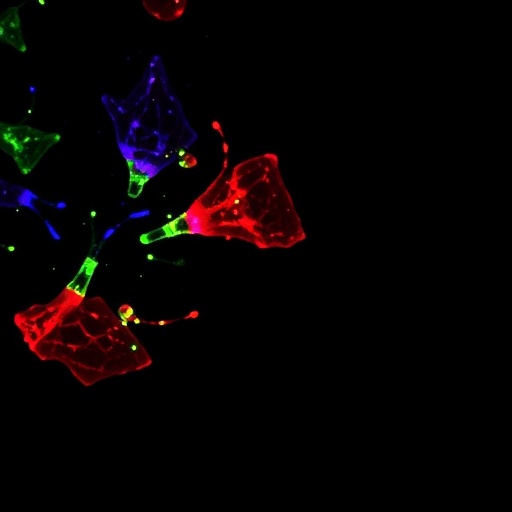A groundbreaking study published recently in Cell Death Discovery unveils a novel molecular mechanism by which renal tubular cells communicate with fibroblasts to mitigate renal interstitial fibrosis, a key pathological process underpinning chronic kidney disease progression. The research, spearheaded by Yang, Bai, Li, and their colleagues, centers on the exosomal microRNA miR-122-5p and its vital role in modulating fibroblast activity through the hypoxia-inducible factor 1-alpha (HIF-1α) signaling pathway. This discovery not only enriches our understanding of kidney fibrosis but also opens promising therapeutic avenues targeting intercellular communication within the renal microenvironment.
Renal interstitial fibrosis is a hallmark feature of chronic kidney disease, characterized by excessive accumulation of extracellular matrix proteins in the renal interstitium. This fibrotic remodeling contributes to the gradual loss of renal function and ultimately kidney failure. Despite extensive research, effective therapeutic strategies to halt or reverse this process have remained elusive, largely due to the complex interplay between various renal cell types driving fibrosis. The study underlines that tubular epithelial cells, beyond their filtering roles, actively participate in intercellular crosstalk by releasing exosomes—nano-sized extracellular vesicles capable of transferring functional RNA molecules to neighboring cells.
MicroRNAs (miRNAs), small non-coding RNA molecules, have emerged as potent post-transcriptional regulators of gene expression. Within this landscape, miR-122-5p has garnered attention for its multifaceted roles in different tissues, but its involvement in renal fibrosis was previously uncharted territory. The researchers isolated exosomal miRNAs from renal tubular cells subjected to fibrotic stimuli and identified a significant enrichment of miR-122-5p, suggesting its potential regulatory role. Remarkably, treating fibrotic fibroblasts with these miR-122-5p-laden exosomes yielded a pronounced reduction in fibrotic markers, implicating miR-122-5p as a critical inhibitor of fibroblast activation.
The mechanistic insights offered by the study hinge on the interplay between miR-122-5p and HIF-1α, a master transcriptional regulator responding to cellular oxygen levels. HIF-1α is well-documented to orchestrate various biological processes, including metabolism, angiogenesis, and fibrosis. Through elegant molecular assays, the investigators demonstrated that miR-122-5p directly targets HIF-1α mRNA in fibroblasts, leading to decreased protein expression and downstream signaling attenuation. This regulatory axis effectively curtails the fibroblast phenotypic transformation into myofibroblasts, cells primarily responsible for matrix overproduction and scarring.
Perhaps most compelling is the evidence showing that exosome-mediated transfer of miR-122-5p from tubular cells to fibroblasts acts as a natural anti-fibrotic mechanism intrinsic to the kidney. By co-culturing epithelial cells with fibroblasts, the researchers observed a marked decline in fibrogenic gene expression in fibroblasts, contingent on exosomal communication. Disruption of exosome release or miR-122-5p inhibition negated these protective effects, affirming the functional importance of this microRNA-loaded vesicular shuttle in renal tissue homeostasis and injury response.
From a therapeutic standpoint, harnessing the miR-122-5p-HIF-1α axis represents a tantalizing prospect. Current anti-fibrotic treatments are limited and often bear significant side effects. The use of engineered exosomes or synthetic miR-122-5p mimics could provide highly specific interventions that directly modulate fibroblast behavior without systemic toxicity. Moreover, targeting HIF-1α signaling could circumvent the fibrotic cascade at an upstream node, offering a broad-spectrum approach to attenuate chronic kidney scarring.
This study also underscores the broader concept of extracellular vesicle-mediated intercellular communication as a critical determinant in organ homeostasis and pathology. The kidney, characterized by a complex cellular architecture, relies heavily on such nuanced dialogues to regulate repair and remodeling processes. Investigating the cargo specificity of exosomal content under various pathological contexts may reveal additional therapeutic targets beyond miRNAs, including proteins and long non-coding RNAs.
The authors utilized a multifaceted experimental framework combining in vitro cell culture systems, exosome isolation and characterization, gene expression profiling, and functional assays to dissect this pathway with high precision. Importantly, they complemented these mechanistic insights with in vivo models of renal fibrosis, demonstrating that augmenting miR-122-5p levels ameliorates fibrotic progression, validating translational relevance.
Additionally, the study invites reflection on the role of hypoxia and metabolic stress in shaping fibrotic microenvironments. Given that the HIF-1α pathway responds dynamically to oxygen deprivation, the miR-122-5p dependent modulation of this factor may constitute an adaptive response mitigating maladaptive fibrosis induced by chronic hypoxic stress commonly observed in diseased kidneys. This provides a physiological context linking microenvironmental cues to molecular regulators of fibrosis.
Future research directions involve exploring the regulatory networks controlling miR-122-5p expression in tubular cells and deciphering how these pathways can be manipulated therapeutically. Investigations into patient-derived samples could ascertain the clinical relevance of these findings, potentially enabling biomarker development for early detection or monitoring therapeutic efficacy in renal fibrosis.
Moreover, the therapeutic use of exosome-based delivery systems is gaining momentum across biomedical fields. This study adds to the growing evidence that exosomes can be harnessed as biocompatible and efficient vehicles for targeted gene therapies. Optimizing exosome isolation, loading, and targeting strategies specific to kidney fibroblasts will be essential steps toward clinical application.
Importantly, while the study focuses on renal fibrosis, the underlying principles of miRNA-mediated exosomal communication may extend to fibrotic diseases in other organs, such as the liver, lungs, and heart. Cross-organ comparisons could reveal conserved mechanisms and therapeutic targets, broadening the impact of these findings.
In conclusion, the identification of exosomal miR-122-5p from tubular cells as a pivotal regulator of fibroblast phenotype via HIF-1α repression represents a significant advancement in nephrology research. This discovery not only enriches the molecular understanding of fibrogenesis but also frames a potential new frontier for anti-fibrotic therapies utilizing the body’s endogenous regulatory systems. As chronic kidney disease continues to pose a global health challenge, innovations stemming from such molecular insights are vital for transforming patient outcomes and healthcare strategies.
Subject of Research: The role of exosomal miR-122-5p derived from renal tubular cells in ameliorating renal interstitial fibrosis through the regulation of fibroblasts via HIF-1α.
Article Title: Exosomal miR-122-5p from tubular cells ameliorates renal interstitial fibrosis by regulating fibroblasts via HIF-1α.
Article References:
Yang, J., Bai, F., Li, Y. et al. Exosomal miR-122-5p from tubular cells ameliorates renal interstitial fibrosis by regulating fibroblasts via HIF-1α. Cell Death Discov. 11, 474 (2025). https://doi.org/10.1038/s41420-025-02739-8
Image Credits: AI Generated




